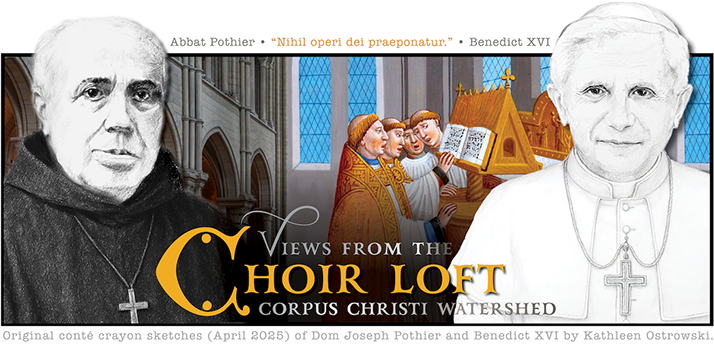 EFORE AND AFTER Masses, I’m always extremely busy. Anyone who’s been a choirmaster will understand. We have numerous Masses and numerous choirs (to say nothing of our weekly solemn Vespers). That means I’m always frantically running around like a chicken with its head cut off. One Mass has barely ended when it’s time to start preparing another choir for the next Mass—and warming up the singers (and giving them last minute instructions) is crucial.
EFORE AND AFTER Masses, I’m always extremely busy. Anyone who’s been a choirmaster will understand. We have numerous Masses and numerous choirs (to say nothing of our weekly solemn Vespers). That means I’m always frantically running around like a chicken with its head cut off. One Mass has barely ended when it’s time to start preparing another choir for the next Mass—and warming up the singers (and giving them last minute instructions) is crucial.
A Lady Approached Me: Recently, a woman (whom I’d never seen at church before) came and insisted that she be allowed to speak to me after Mass. She demanded to know the name of the hymn we had sung for Communion, declaring it to be the most beautiful song she’d ever heard. I told her it was #506 in the Brébeuf hymnal: a gorgeous contemporary melody by Kevin Allen. Below is the recording from that day. Notice how the choir jumps to SATB harmony ever other verse:
![]()
Alternating Women & Men: We don’t like to sing SATB straight through. We like to use women in unison for some verses, and SATB for the other verses. Below is another example from a recent Mass. (Remember that microphones cannot “capture” a true choral sound, so recordings do not do justice to the beauty of a live experience.) Which do you like better? The women in unison or the SATB verses? I can’t decide:
![]()
Not Rocket Science: Many of these choir members had never sung harmonies until February—just a few months ago! These are not professional singers. Yet, the Brébeuf hymnal uses an ingeniously marvelous method of typesetting that places each verse directly under the musical notes. This makes it possible for volunteer choirs to add elegant SATB harmonies to the hymns:
![]()
We Must Attract: The sacred liturgy is supposed to be a “delight.” It ought to be beautiful. The fact that somebody I’ve never met insisted on finding out the name of that Kevin Allen hymn means we’re on the right track. “Beauty” should not be a dirty word. If a choir singing plainsong, motets, hymns, and polyphony causes people to hate coming to Mass, that’s not good. Indeed, it might be an indication the music is not being sung properly. Liturgical music should be delightful in the best sense. If you don’t know what hymns are worth singing, pick up a copy of the Brébeuf hymnal. Its tunes are simple—easy to sing—yet they are resilient, well-constructed, dignified, melodious, memorable, traditional, and (to coin a phrase) delightful.
![]()

